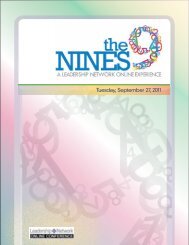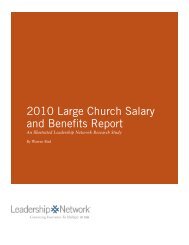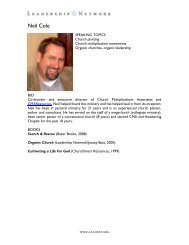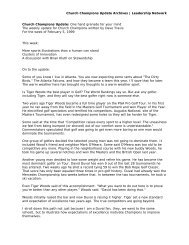ARE WE A PEOPLE AT HALF TIME? - Leadership Network
ARE WE A PEOPLE AT HALF TIME? - Leadership Network
ARE WE A PEOPLE AT HALF TIME? - Leadership Network
Create successful ePaper yourself
Turn your PDF publications into a flip-book with our unique Google optimized e-Paper software.
The Ascent<br />
of a Leader:<br />
How Ordinary<br />
Relationships<br />
Develop<br />
Extraordinary<br />
Character and<br />
Influence<br />
by Bill Thrall,<br />
Bruce McNicol &<br />
Ken McElrath<br />
EXCERPTED BY CAROL CHILDRESS<br />
Photo by Gregg Lansing<br />
Big Leaders on Short Ladders<br />
Many men and women of influence discover that leadership is like a ladder —<br />
a challenging and unpredictable climb, often stable at the bottom and shaky at the top.<br />
From the bottom, life at the top looks appealing, even alluring, and many leaders attack<br />
the ladder with gusto, confident that they possess what it takes to conquer the rungs.<br />
Yet, when these leaders reach positions of authority, unforeseen instability begins to<br />
surface. The pressures of success, the temptations of privilege, the demands of followers<br />
and the isolation of leadership leave deep impressions on the rungs — caused by the<br />
white-knuckle grip of the leaders. Many look for a way to stabilize their situation, but<br />
too many leaders come crashing down.<br />
The Capacity Ladder<br />
Each person has the opportunity to make use of ladders to scale their respective walls.<br />
The ladder most are familiar with is one we call the capacity ladder. The ascent up the<br />
capacity ladder begins with the first rung: discovering what I can do. In addition to<br />
specific skills, your what-I-can-do inventory may include natural leadership inclinations,<br />
a winsome personality, a dynamic influence or an ability to craft a compelling vision or<br />
to persuade.<br />
Moving up to the second rung — develop my capacities — grants more influence to the<br />
leader. At this level, the leader sharpens talents and gifts. Early training often occurs in<br />
college and graduate school, and there is further honing during the leader's first<br />
engagements with companies, organizations or religious bodies.<br />
The leader's successful scaling of the first two rungs attracts the attention of executives,<br />
administrators, professors and thousands of group members or constituents who choose<br />
their leaders. This attention catapults the person to the third rung, where decisionmakers<br />
and followers award a title, position or office. This step up leads naturally to the<br />
fourth and final rung: attain individual potential. From below, the top rung of the<br />
capacity ladder looks great — honor, glory, respect and power — the results of effective<br />
leadership influence. But the capacity ladder, though necessary, is not sufficient to ensure<br />
that our abilities will result in positive influence or an enduring legacy.<br />
When leaders with undeveloped character rises up the capacity ladder, their actions<br />
have a negative impact on those around them. Even at the top of the capacity ladder,<br />
leaders may not have begun to address the disconnect between the development of their<br />
character and the development of their capacities.<br />
The Character Ladder<br />
In addition to rungs, all ladders need rails, the vertical posts that hold the rungs in place.<br />
One rail of the character ladder is environment and the other rail is relationships.<br />
We begin our climb up the character ladder with an act of trust. We all entrust ourselves<br />
to something, whether it is God, money, spouse, career, productivity, ourselves or<br />
whatever. Our character, and therefore our influence, flows from our choices of whom,<br />
what, when and where we believe. Such trust — often referred to as faith — lives at<br />
the center of our lives, shaping who we are.<br />
me. In order to take this step, we must allow the myth of self-sufficiency to end. At<br />
the bottom of the capacity ladder, we focus on discovering what we can do, whereas<br />
on the character ladder, we focus on discovering what God can do. Early on the<br />
capacity ladder, we awaken to our potential for what we think we can offer to God<br />
and this world. On the character ladder, we awaken to our destiny under God.<br />
This merging between our plans and God's intentions for our character is the goal<br />
of the character ladder. God’s plan for our destiny involves meaningful interaction<br />
with other human beings in communities and environments of grace. Lonely leaders<br />
are everywhere, although power or wealth may anesthetize their souls and soothe them<br />
into a false sense of security. How do we overcome isolation that threatens to rob us of<br />
our influence The answer is found in the second rung on the character ladder — choose<br />
vulnerability.<br />
5<br />
(continued on page 6)<br />
www.leadnet.org







